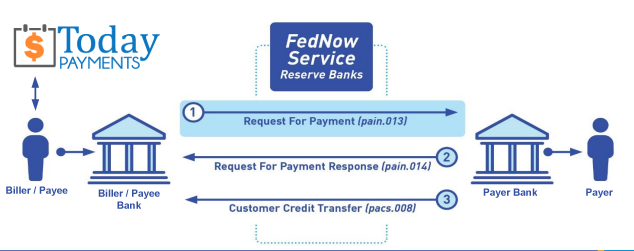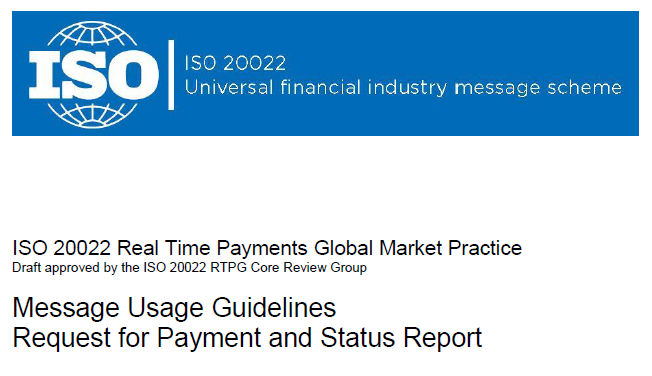Import FedNow File
TodayPayments.com delivers enterprise-grade payment processing and invoicing via FedNow® and RTP®. With support for ISO 20022 file imports, RfP-based invoicing, and alias-powered payments, we make it easy for merchants of any size or risk profile to get paid instantly—across all 50 states and multiple financial institutions.
- "Invoicing Certainty. Instant Payment Clarity."
- "Real-Time Payments Made Simple, Secure, and Scalable."
- "Send, Click, Funded – RfP Payment Automation Starts Here."
What is an “Import FedNow® RfP File” and Why It Matters
![]() Import FedNow® Request for Payment File –
Real-Time Payments for Modern Businesses
Import FedNow® Request for Payment File –
Real-Time Payments for Modern Businesses
The New Era of Digital Invoicing and
Instant Settlement
In the digital economy, time is currency—and
your ability to get paid instantly is the new business
advantage. With FedNow® Request for Payment (RfP) imports,
powered by ISO 20022 messaging, your business can generate
real-time payment requests through Excel, XML, or JSON formats
and deliver them directly to customers via mobile, email, or SMS.
An Import FedNow® Request for Payment File allows you to upload structured payment requests for:
- One-time transactions
- Recurring billing
- Bulk/batch payments to hundreds of customers
Whether you're invoicing for services, subscriptions, or wholesale goods, our platform lets you generate and send RfPs that customers can pay immediately using their preferred bank—resulting in "Good Funds" availability in seconds.
RfP Files are structured in:
- .Excel (.xlsx)
- .XML
- .JSON
All processed securely through ISO 20022 messaging protocols.
No more waiting for checks to clear. No more ACH delays. TodayPayments.com empowers merchants to import RfP files and trigger instant payments and reconciliations across any U.S. financial institution, at any time—day or night.
Mobile, Email, and SMS-Powered Request for Payments (RfP)
We don’t just send invoices—we deliver smart digital payment requests to wherever your customers are:
- Mobile phones (SMS)
- Email inboxes
- Text-to-pay links
- Secure Hosted Payment Pages
Using alias-based routing, you don’t even need full financial details. Simply send to a cell phone number or email, and the payment will route securely via FedNow® or RTP®, fulfilling your RfP instantly.
Key Benefits & Features of FedNow® RfP File Imports
- Instant real-time settlement with FedNow® or RTP®
- ISO 20022-compliant structured files
- Import via Excel, XML, or JSON
- Alias-based invoicing using mobile/email instead of account numbers
- Recurring payment support for SaaS, rent, payroll, and more
- B2B, B2C, C2B, A2A transaction compatibility
- Hosted Payment Page with clickable pay links
- QuickBooks® Online integration
- Multiple MIDs for aliases, subsidiaries, or locations
- Automated batch uploads and reconciliation
- Support for over 100 aliases and payee accounts
- Real-time reconciliation and reporting for accounting teams
- Support for high-risk, bad-credit, and unbanked merchants
To import a FedNow Request for Payment (RfP) file, you'll need to format and process the file in compliance with FedNow's standards, based on your financial institution's integration system. Below, I’ll walk you through a generic process for importing an RfP file, using CSV, XML, and JSON formats, assuming your financial institution accepts these types for processing payments.
1. CSV Format
The CSV format represents simple tabular data, where each row corresponds to a FedNow payment request. You need to ensure your CSV structure meets the specific FedNow RfP requirements.
Example CSV Structure:
csv
TransactionID, RequestorAccount, BeneficiaryAccount, Amount, DueDate, RequestDate, Description
123456, 111111111, 222222222, 500.00, 2023-09-15, 2023-09-12, Payment for invoice #789
789123, 333333333, 444444444, 250.00, 2023-09-16, 2023-09-12, Payment for services rendered
- TransactionID: Unique identifier for the payment request.
- RequestorAccount: The sender's account number or routing details.
- BeneficiaryAccount: The receiver's account number.
- Amount: The amount requested.
- DueDate: The date when the payment is due.
- RequestDate: The date when the request is created.
- Description: Additional information about the payment.
2. XML Format
XML offers a more structured approach and may include additional metadata that can be processed by the FedNow system.
Example XML Structure:
xml
<PaymentRequests>
<Request>
<TransactionID>123456</TransactionID>
<RequestorAccount>111111111</RequestorAccount>
<BeneficiaryAccount>222222222</BeneficiaryAccount>
<Amount>500.00</Amount>
<DueDate>2023-09-15</DueDate>
<RequestDate>2023-09-12</RequestDate>
<Description>Payment for invoice #789</Description>
</Request>
<Request>
<TransactionID>789123</TransactionID>
<RequestorAccount>333333333</RequestorAccount>
<BeneficiaryAccount>444444444</BeneficiaryAccount>
<Amount>250.00</Amount>
<DueDate>2023-09-16</DueDate>
<RequestDate>2023-09-12</RequestDate>
<Description>Payment for services rendered</Description>
</Request>
</PaymentRequests>
3. JSON Format
JSON is commonly used in APIs and provides an easy-to-read and process format for payment requests.
Example JSON Structure:
json
{
"paymentRequests": [
{
"transactionID": "123456",
"requestorAccount": "111111111",
"beneficiaryAccount": "222222222",
"amount": 500.00,
"dueDate": "2023-09-15",
"requestDate": "2023-09-12",
"description": "Payment for invoice #789"
},
{
"transactionID": "789123",
"requestorAccount": "333333333",
"beneficiaryAccount": "444444444",
"amount": 250.00,
"dueDate": "2023-09-16",
"requestDate": "2023-09-12",
"description": "Payment for services rendered"
}
]
}
Steps for Importing the FedNow Request for Payment File:
Step 1: File Preparation
- Ensure the file is formatted properly in the desired structure (CSV, XML, or JSON).
- Make sure the data is accurate and adheres to any specific fields required by FedNow or your institution.
Step 2: Authentication
Your institution's FedNow integration would require secure authentication (via API keys, OAuth tokens, etc.) to interact with the FedNow system. Ensure you have the correct credentials for the file upload.
Step 3: Upload the File
There are two primary ways to upload the payment file depending on how your institution is integrated with the FedNow system:
- Using an API:
- Your institution may provide a REST API to upload the request for payment.
- Example API call using JSON:
POST /fednow/rfp/import
Content-Type: application/json
Authorization: Bearer <YourAPIToken>
{
"paymentRequests": [...]
}
- For XML or CSV, you can upload files using a similar POST request but adjust the Content-Type header accordingly (e.g., application/xml or text/csv).
- Manual Upload:
- Some financial institutions may offer a secure portal where you can manually upload the payment request file (CSV, XML, etc.).
Step 4: Validation
After uploading, the system will validate the payment requests to ensure they meet the FedNow standards. If there are any errors (e.g., invalid account numbers, wrong formats), the system will return error messages or logs that need to be corrected.
Step 5: Monitor Status
Monitor the status of the imported file through:
- API responses (successful processing or error logs).
- Notifications or reports from the FedNow system.
- Your financial institution's backend portal, where statuses such as "Pending," "Processed," or "Failed" may appear.
Key Points:
- Ensure all required fields (transaction ID, accounts, amounts, etc.) are included in the file.
- Follow the FedNow and your financial institution's specific file format requirements.
- Use appropriate authentication methods to upload or transmit the file securely.
- Monitor the file processing and handle any errors as needed.
For specific guidance, you may need to consult your financial institution's FedNow documentation, as requirements can vary slightly depending on the setup and payment infrastructure.
Import. Invoice. Instantly Paid.
With TodayPayments.com, your business unlocks:
✅ Seamless FedNow® and RTP® file
imports
✅ ISO 20022-compatible RfP messaging
✅ Hosted payment links sent via mobile, text, or
email
✅ Instant deposits with “Good
Funds” confirmation
✅ Real-time
reporting and reconciliation
No bank visit. No waiting. Just fast, secure, and reliable payment execution—all through our powerful RfP import solution.
📌 Apply now at
https://www.TodayPayments.com
📌 Upload
your RfP files today and start receiving instant payments!
Creation Request for Payment Bank File
Call us, the .csv and or .xml Request for Payment (RfP) file you need while on your 1st phone call! We guarantee our reports work to your Bank and Credit Union. We were years ahead of competitors recognizing the benefits of RequestForPayment.com. We are not a Bank. Our function as a role as an "Accounting System" with Real-Time Payments to work with Billers / Payees to create the Request for Payment to upload the Biller's Bank online platform. U.S. Companies need help to learn the RfP message delivering their bank. Today Payments' ISO 20022 Payment Initiation (PAIN .013) shows how to implement Create Real-Time Payments Request for Payment File up front delivering a message from the Creditor (Payee) to it's bank. Most banks (FIs) will deliver the message Import and Batch files for their company depositors for both FedNow and Real-Time Payments (RtP). Once uploaded correctly, the Creditor's (Payee's) bank continues through a "Payment Hub", with messaging to the Debtor's (Payer's) bank.

... easily create Real-Time Payments RfP files. No risk. Test with your bank and delete "test" files before APPROVAL on your Bank's Online Payments Platform.
Today Payments is a leader in the evolution of immediate payments. We were years ahead of competitors recognizing the benefits of Same-Day ACH
and Real-Time Payments funding. Our business clients receive faster
availability of funds on deposited items and instant notification of
items presented for deposit all based on real-time activity.
Dedicated to providing superior customer service and
industry-leading technology.


1) Free ISO 20022 Request for Payment File Formats, for FedNow and Real-Time Payments (The Clearing House) .pdf for you manually create "Mandatory" (Mandatory data for completed file) fields, start at page 4, with "yellow" highlighting. $0.0 + No Support
2) We create .csv or .xml formatting using your Bank or Credit Union. Create Multiple Templates. Payer / Customer Routing Transit and Deposit Account Number may be required or Nickname, Alias to import with your bank. You can upload or "key data" into our software for File Creation of "Mandatory" general file.
Fees = $57 monthly, including Support Fees and Batch Fee, Monthly Fee, User Fee, Additional Payment Method on "Hosted Payment Page" (Request for file with an HTML link per transaction to "Hosted Payment Page" with ancillary payment methods of FedNow, RTP, ACH, Cards and many more!) + $.03 per Transaction + 1% percentage on gross dollar file,
3) We add a URI for each separate Payer transaction. Using URI, per transaction, will identify and reconcile your Accounts Receivable.
Fees Above 2) plus $29 monthly additional QuickBooks Online "QBO" formatting, and "Hosted Payment Page" and WYSIWYG
4) Above 3) plus Create "Total" (over 600 Mandatory, Conditional & Optional fields of all ISO 20022 Pain .013) Price on quote.
Each day, thousands of businesses around the country are turning their transactions into profit with real-time payment solutions like ours.
Start using our Bank Reconciliation and Aging of Request for Payments:
Dynamic integrated with FedNow & Real-Time Payments (RtP) Bank Reconciliation: Accrual / Cash / QBO - Undeposited Funds
Contact Us for Request For Payment payment processing

